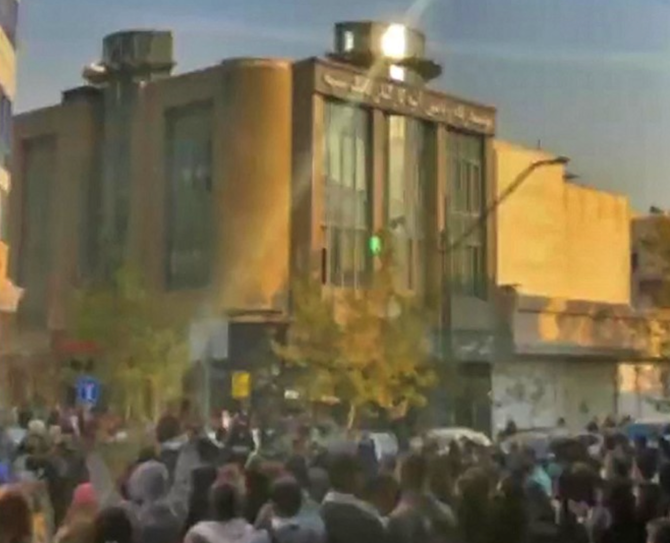
- ARAB NEWS
- 06 Jul 2025

The Iranian regime has been attempting to downplay the crisis it faces domestically in order to project power and paint a picture of itself ruling via a formidable, sustainable, legitimate and popular government.
For example, Supreme Leader Ali Khamenei has called the ongoing nationwide uprising as “scattered riots” designed “by the enemy” and he described the protesters as “thugs, robbers and extortionists.” He explained in a recent speech: “These scattered riots are the passive and clumsy design of the enemy against the great and innovative developments and movements of the Iranian nation.” He also characterized the protests across the country as a “minor incident,” saying: “The constructions, great executive works, effective legislation, big judicial works and important issues in foreign policy should not be sidelined by these minor incidents.”
Furthermore, the regime’s police and security forces, which are backed and emboldened by the supreme leader, continue to employ full-scale brute force in order to suppress the protesters.
Nevertheless, it is important to point out that, even though the protests do not appear to be organized under a single leadership, the collective nature and the danger of mass demonstrations to the regime should not be underestimated. History has shown that such collective protests can endanger the hold on power of ruling governments.
The protests are not a “minor incident” or “scattered protests,” as Khamenei claims. Even one of the regime’s main institutions has acknowledged that an overwhelming majority of the population — nearly 75 percent — is willing to participate in protests. The country’s Supreme National Defense University, which focuses on national security, warned government officials about such a danger in a recently published study.
It concluded: “In the course of the social and political developments of the last decade, all kinds of activism have been created and have become new centers for social and cultural communication and … the creation of political power. All these factors have completely changed aspects of Iranian society and, along with the two protest waves of January 2018 and November 2019, the suspicion that Iranian society is on the threshold of political collapse has been strengthened.”
The collective nature and the danger of mass demonstrations to the regime should not be underestimated.
Dr. Majid Rafizadeh
Indeed, the series of uprisings seen around the country in 2018, 2019 and now in 2022 point to the people’s fury and the depth of popular support for regime change. The first of these waves of popular protest erupted nearly four years ago over the state of the Iranian economy. It spread across the country and took on an increasingly political tone. The resistance movement encompassed a huge number of cities and towns, with each of them providing an outlet for unusually provocative slogans.
The chants included “Death to the dictator,” “Hard-liners, reformers, game over,” and “Our enemy is right here.”
Contrary to Khamenei’s claim that these uprisings are trivial, not only has the number of protests been rising in the last few years, but their scope and longevity has also risen, as people have become more empowered to stand up to the authorities.
Chants that were at first focused on the economy have long since turned into political slogans, such as “Freedom, freedom, freedom,” “From Kurdistan to Tehran, I sacrifice my life for Iran,” “We are all Mahsa (Amini), fight and we will fight back,” and “Imprisoned teachers must be freed.” The other major warning is that Khamenei, who is the main figure of the theocracy, has become a permanent fixture in the protesters’ slogan, with people chanting “This year is a year of sacrifice. Seyyed Ali (Khamenei) will be overthrown,” and “Death to Khamenei.”
Some Iranian officials and organizations only blame the economy for the protests. For instance, the study by the Supreme National Defense University acknowledged that 67.2 percent of Iranians have experienced a “relative state of deprivation” at “high levels,” while 82.2 percent “insist they have not yet met their needs” and “59.4 percent of people consider the country’s situation anomalous and abnormal.”
The dire economic situation is indeed a critical factor driving the ongoing protests, but there are other reasons for people’s anger toward the theocratic establishment that should not be disregarded. These grievances include people’s dissatisfaction with the regime’s political repression, restrictive religious laws, human rights violations, hemorrhaging of the nation’s resources on proxy and militia groups across the region — such as the Houthis, Hezbollah and Iraqi Shiite militia groups — and the government’s reluctance to improve the living standards of its own people.
In a nutshell, the Iranian regime appears to be facing an unsolvable crisis. While the authorities attempt to downplay the protests, the latest uprising and mass demonstrations should be a significant warning to the Iranian leaders and their hold on power.